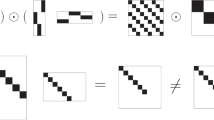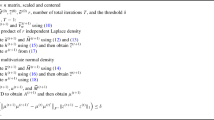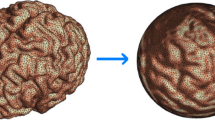Abstract
Images can be coded accurately using a sparse set of vectors from a learned overcomplete dictionary, with potential applications in image compression and feature selection for pattern recognition. We present a survey of algorithms that perform dictionary learning and sparse coding and make three contributions. First, we compare our overcomplete dictionary learning algorithm (FOCUSS-CNDL) with overcomplete independent component analysis (ICA). Second, noting that once a dictionary has been learned in a given domain the problem becomes one of choosing the vectors to form an accurate, sparse representation, we compare a recently developed algorithm (sparse Bayesian learning with adjustable variance Gaussians, SBL-AVG) to well known methods of subset selection: matching pursuit and FOCUSS. Third, noting that in some cases it may be necessary to find a non-negative sparse coding, we present a modified version of the FOCUSS algorithm that can find such non-negative codings. Efficient parallel implementations in VLSI could make these algorithms more practical for many applications.
Similar content being viewed by others
References
R. C. Gonzales and R. E. Woods, “Digital Image Processing,” Addison-Wesley, Reading, Massachusetts, 1993.
E. Oja, “A Simplified Neuron Model as a Principal Component Analyzer,” J. Math. Biol., vol. 15, 1982, pp. 267–273.
T. T. Pham and R. J. P. deFigueiredo,“Maximum Likelihood Estimation of a Class of Non-Gaussian Densities with Application to ℓ p Deconvolution,” IEEE Trans. Acoust. Speech Signal Process, vol. 37, no. 1, January 1989, pp. 73–82.
C. Jutten and J. Hérault, “Blind Separation of Sources. Part I. An Adaptive Algorithm Based on Neuromimetic Architecture,” Signal Process, vol. 24, 1991, pp. 1–10.
K. Kreutz-Delgado, J. F. Murray, B. D. Rao, K. Engan, T.-W. Lee, and T. J. Sejnowski, “Dictionary Learning Algorithms for Sparse Representation,” Neural Comput., vol. 15, no. 2, February 2003, pp. 349–396.
M. S. Lewicki and T. J. Sejnowski, “Learning Overcomplete Representations,” Neural Comput., vol. 12, no. 2, February 2000, pp. 337–365.
K. Engan, J. H. Husoy, and S. O. Aase, “Frame Based Representation and Compression of Still Images,” in Proc. ICIP, 2001, pp. 1–4.
B. A. Olshausen and D. J. Field, “Sparse Coding with an Overcomplete Basis Set: A Strategy Employed by V1?,” Vis. Res., vol. 37, 1997, pp. 3311–3325.
D. M. Weber and D. Casasent, “Quadratic Gabor Filters for Object Detection,” IEEE Trans. Image Process, vol. 10, no. 2, February 2001, pp. 218–230.
B. D. Rao and K. Kreutz-Delgado, “An Affine Scaling Methodology for Best Basis Selection,” IEEE Trans. Signal Process, vol. 47, 1999, pp. 187–200.
M. E. Tipping, “Sparse Bayesian Learning and the Relevance Vector Machine,” J. Mach. Learn. Res., vol. 1, 2001, pp. 211–244.
S. F. Cotter, J. Adler, B. D. Rao, and K. Kreutz-Delgado, “Forward Sequential Algorithms for Best Basis Selection,” IEE Proc., Vis. Image Signal Process, vol. 146, no. 5, October 1999, pp. 235–244.
J. F. Murray and K. Kreutz-Delgado, “An Improved FOCUSS-based Learning Algorithm for Solving Sparse Linear Inverse Problems,” in Conference Record of the 35th Asilomar Conference on Signals, Systems and Computers (IEEE), vol. 1, Pacific Grove, California, November 2001, pp. 347–351.
M. S. Lewicki and B. A. Olshausen, “A probabilistic Framework for the Adaptation and Comparison of Image Codes,” J. Opt. Soc. Am. A, vol. 16, no. 7, July 1999, pp. 1587–1601.
K. Engan, “Frame Based Signal Representation and Compression.” PhD thesis, Stavanger Universty College, Norway, 2000.
P. Paatero and U. Tapper, “Positive Matrix Factorization: A Nonnegative Factor Model with Optimal Utilization of Error Estimates of Data Values,” Environmetrics, vol. 5, 1994, pp. 111–126.
D. D. Lee and H. S. Seung, “Learning the Parts of Objects by Non-negative Matrix Factorization,” Nature, vol. 401, October 1999, pp. 788–791.
P. O. Hoyer, “Non-negative Sparse Coding,” in Proc. of the 12th IEEE Workshop on Neural Networks for Sig. Proc., 2002, pp. 557–565.
M. D. Plumbley, “Algorithms for Nonnegative Independent Component Analysis,” IEEE Trans. Neural Netw., vol. 14, no. 3, May 2003, pp. 534–543.
S. Chen and D. Donoho, “Atomic Decomposition by Basis Pursuit,” SIAM J. Sci. Comput., vol. 20, no. 1, 1998, pp. 33–61.
D. Donoho and M. Elad, “Optimally Sparse Representation in General (Nonorthogonal) Dictionaries via l 1 Minimization,” Proc. Natl. Acad. Sci. U. S. A., vol. 100, no. 5, March 2003, pp. 2197–2202.
D. P. Wipf and B. D. Rao, “Probabilistic Analysis for Basis Selection via ℓ p Diversity Measures,” in Proc. of the Intl. Conf. on Acoustics, Speech, and Signal Processing, 2004 (ICASSP ’04), vol. 2, May 2004.
D. P. Wipf and B. D. Rao, “Sparse Bayesian Learning for Basis Selection,” IEEE Trans. Signal Process, vol. 52, no. 8, 2004, pp. 2153–2164.
I. F. Gorodnitsky, J. S. George, and B. D. Rao, “Neuromagnetic Source Imaging with FOCUSS: A Recursive Weighted Minimum Norm Algorithm,” Electroencephalogr. Clin. Neurophysiol., vol. 95, no. 4, 1995, pp. 231–251.
R. Vigário and E. Oja, “Independence: A New Criterion for the Analysis of the Electromagnetic Fields in the Global Brain?,” Neural Netw., vol. 13, 2000, pp. 891–907.
C. M. Bishop and M. E. Tipping, “Bayesian Regression and Classification,” in Advances in Learning Theory: Methods, Models and Applications, volume 190 of NATO Science Series III: Computer Systems Sciences, J. Suykens, G. Horvath, S. Basu, C. Micchelli, and J. Vandewalle (Eds.), IOS, Amsterdam, 2003, pp. 267–285.
R. J. Muirhead, “Aspects of Multivariate Statistical Theory,” Wiley, New York, 1982.
S. G. Mallat and Z. Zhang, “Matching Pursuits with Time-frequency Dictionaries,” IEEE Trans. Signal Process, vol. 41, no. 12, 1993, pp. 3397–3415.
S. F. Cotter, “Subset Selection Algorithms with Applications.” PhD thesis, University of California at San Diego, 2001.
K. Engan, K. Skretting, and J. H. Husoy, “A Family of Iterative LS-based Dictionary Learning Algorithms, ILS-DLA, for Sparse Signal Representation,” to appear, IEEE Trans. on Signal Processing.
M. Girolami, “A Variational Method for Learning Sparse and Overcomplete Representations,” Neural Comput., vol. 13, 2001, pp. 2517–2532.
J. A. Palmer and K. Kreutz-Delgado, “A General Framework for Component Estimation,” in Proc. 4th Intl. Symp. on ICA, 2003.
M. Aharon, M. Elad, and A. Bruckstein, “K-SVD: An Algorithm for Designing of Overcomplete Dictionaries for Sparse Representation,” to appear, IEEE Trans. on Signal Processing.
S. A. Nene, S. K. Nayar, and H. Murase, “Columbia Object Image Library (COIL-100),” Technical Report CUCS-006-96, Columbia University, 1996.
G. H. Golub and C. F. V. Loan, “Matrix Computations,” John Hopkins University Press, Baltimore, Maryland, 1983.
S. Peng and S. Sedukhin, “Parallel Algorithm and Architectures for Two-step Division-free Gaussian Elimination,” in Algorithms and Architectures for Parallel Processing, 3rd International Conference on (ICAPP 97), 1997, pp. 489–502.
J.-C. Tsay and P.-Y. Chang, “Design of Efficient Regular Arrays for Matrix Multiplication by Two-step Regularization,” IEEE Trans. Parallel Distrib. Syst., vol. 6, no. 2, February 1995, pp. 215–222.
K. Muhammad and K. Roy, “Reduced Computational Redundancy Implementation of DSP Algorithms Using Computation Sharing Vector Scaling,” IEEE Transactions on VLSI Systems, vol. 10, no. 3, 2002, pp. 292–300.
D. Zhang, “Parallel VLSI Neural System Design,” Springer, Berlin Heidelberg New York, 1998.
Author information
Authors and Affiliations
Corresponding author
Rights and permissions
About this article
Cite this article
Murray, J.F., Kreutz-Delgado, K. Learning Sparse Overcomplete Codes for Images. J VLSI Sign Process Syst Sign Image Video Technol 45, 97–110 (2006). https://doi.org/10.1007/s11265-006-9774-5
Received:
Revised:
Accepted:
Published:
Issue Date:
DOI: https://doi.org/10.1007/s11265-006-9774-5




